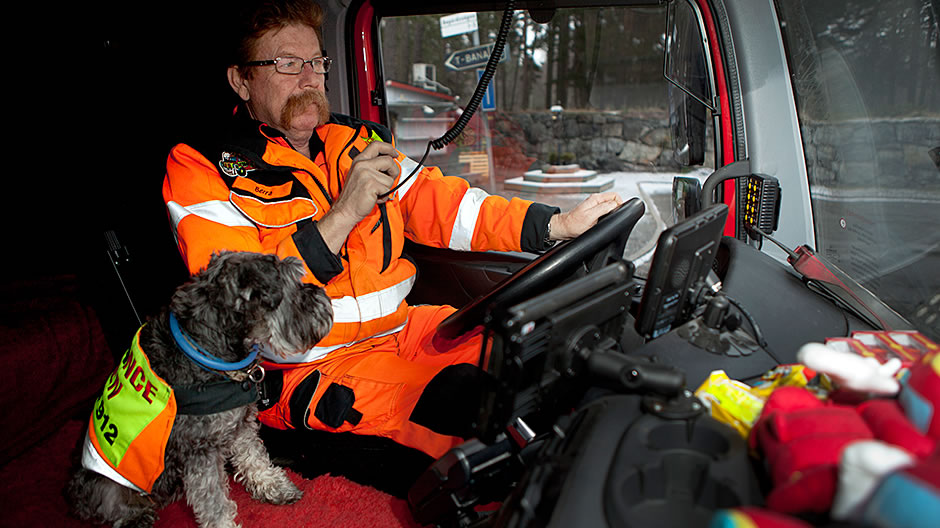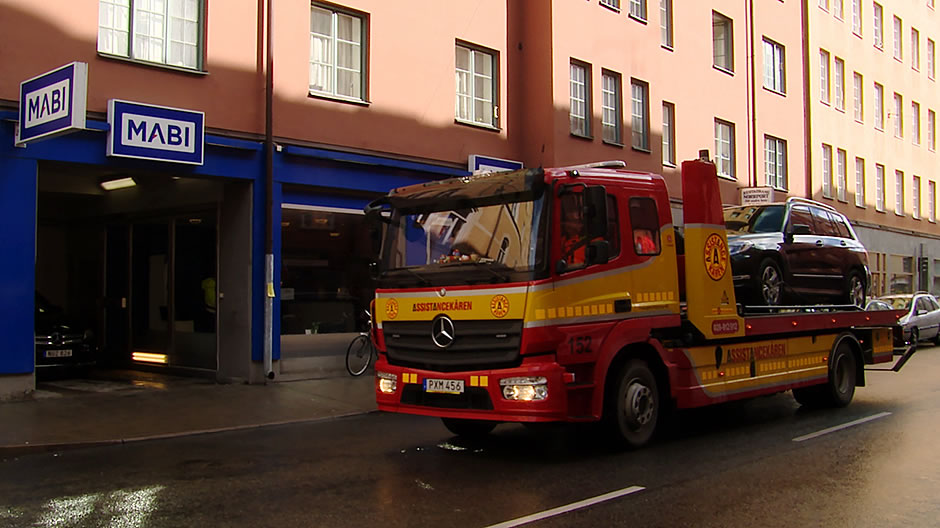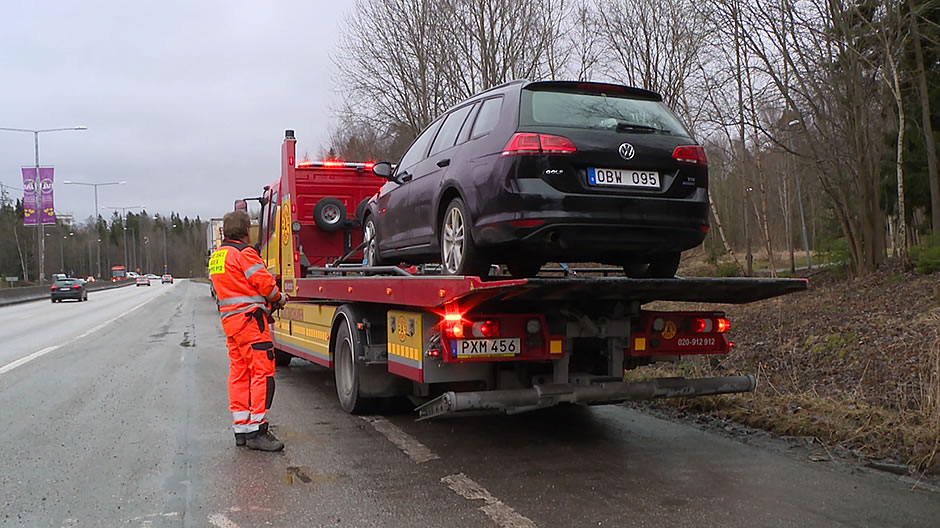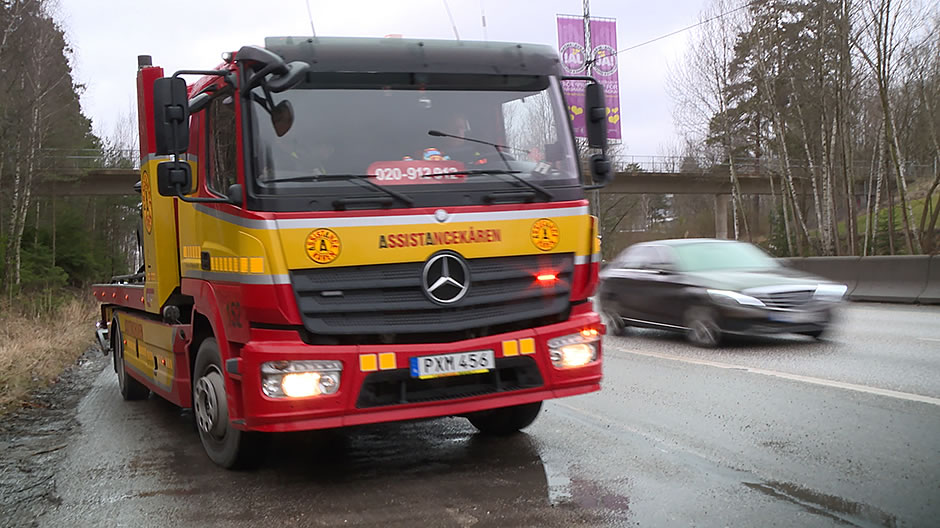
Bärgar-Berra and Doris – the recovery team that become TV stars
Story
Can truckers become TV stars? A few years ago, that was something fairly unimaginable. But since the advent of "Ice Road Truckers" and other similar series, that has now completely changed. The series "Vägens Hjältar" ("Heroes of the Urban Highways") is a big hit in Sweden. Broadcast on the Swedish channel 5, it reports on recovery operations in and around Stockholm. One of the favourite characters of the series is Bärgar-Berra, who solves a good many problems together with his Schnauzer Doris.

Recovery service employee Berra and his dog Doris on-call.
Hundreds of thousands of viewers are drawn before their televisions every time "Vägens Hjältar" is on. Watching professional recovery specialists go about their work, and especially how calm and concertedly they manage to solve all of the problems they face provides for a good dose of feel-good and plenty of happy endings.
Incidentally, the series has turned many of its participants into stars. The most famous of all is Bärgar-Berra – or Bertil Silwing, as he is actually called. Together with his trusty companion, his Schnauzer Doris, he drives his Mercedes Atego to emergencies on the road.
"Working in the recovery service is more than a job, it's more
a way of life," says Berra, who has an impressive 30 years of
professional experience to his name.
"You have to be able
to solve problems. It's not about driving to someone somewhere to look
at the damage and then simply say: sorry, I can't do anything to help
you. Simply driving off isn't an option. After all, the people are
dependent on us. They are often also extremely stressed or are
worried, and so part of our work also involves calming them down and
maintaining an overview of the situation at hand."

Often, they have already located a workshop that can help and have even already booked a replacement vehicle before even arriving at the scene of the incident.
Help.
The traffic in and around Stockholm is something quite particular for Sweden. And not just because it is the most busy area of the country, but also because Stockholm was built on a series of islands. That's why the traffic is so dependent on bridges and tunnels – diverting traffic here is virtually impossible. Plus, almost all of the traffic on the roads from southern or northern Sweden runs via the roads that are used by Stockholm's commuters. A single car with engine damage can bring the entire traffic system to a standstill. That's why Stockholm's traffic department uses cameras to keep an eye on the situation and quickly react if needs be. This allows recovery services and, if necessary, emergency services and the police to be sent to the scene of an incident without delay.
"Often, it's simple things like cars with a flat tyre, an empty
fuel tank or similar stuff like that," says Berra.
"In
such cases, speed is of the essence: the car has to be loaded onto the
recovery truck to get the traffic flowing again. It sometimes also
happens that it's something really serious, though. For example that a
driver has become ill behind the wheel or that a car becomes damaged
and that it's not visible on the cameras. We're prepared for
everything and help in any situation."
Berra and his colleagues collaborate with an incredible network of
insurance providers, workshops and car hire companies. Often, they
have already located a workshop that can help and have even already
booked a replacement vehicle before even arriving at the scene of the
incident.
"Our work isn't just about towing cars; it's
about helping people."

A single vehicle with engine damage can bring the entire traffic system to a standstill. In such cases, speed is of the essence: the car has to be loaded onto the recovery truck to get the traffic flowing again.
More consideration on the road.
Over the course of the last few years, the safety of recovery staff has been increasingly discussed. Drivers appear to have forgotten how to release the accelerator pedal and both recovery companies and emergency services have lost colleagues in fatal accidents in recent times. Berra thinks, however, that the TV series has a counter-effect to this development.
"Now people want to talk to us about our work. They better understand what it is we do and I think they are more ready to stop and help other road users. Overall, I find that people drive more carefully when they see we are on the scene. After all, we all have to get along with one another on the road."
The whole aspect of getting along with one another on the road is something of great importance for Berra. "Such a shame that there's not more money invested in checking the behaviour of people on the roads. Tailgating or illegal overtaking manoeuvres should be punished with higher insurance premiums. People are more likely to react if you hit them in their pocket."

Berra's trusty companion – Schnauzer Doris.
In the meantime, Berra isn't simply an employee of a recovery service, rather he is responsible for the station at which he works. The team's fleet also includes three Mercedes-Benz Atego vehicles for recovering passenger cars in Stockholm. One of them has a double loading area so that cars can be transported on two levels. If there is one vehicle loaded at the front, it's possible to transport three vehicles simultaneously with a single vehicle.
"They are great vehicles with a fantastic turning circle and
that's the sort of thing you come to appreciate when you're working in
the field of recovery. We also use these trucks when we receive calls
to inner-city areas as they are just perfect in tight spaces.
What's more, the cab is more spacious than with other manufacturers
and that's also something which you come to enjoy when you have to
transport passengers with you on a regular basis. During filming, the
TV crew always wants us to drive the Mercedes because it offers the
best place on-board."

A Mercedes-Benz Atego which is used in Stockholm for recovering passenger cars. One of them has a double loading area so that cars can be transported on two levels.
Photos: Bertil Silwing




Comment
Please log in to post a comment.
8 comments
Daaankeschön an dieser Stelle 👍👍👍
Daaankeschön an dieser Stelle 👍👍👍